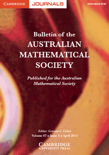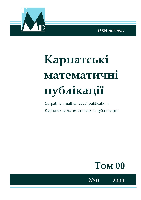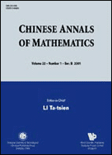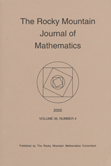
Siberian Electronic Mathematical Reports-Sibirskie Elektronnye Matematicheskie Izvestiya
Scope & Guideline
Exploring New Horizons in Mathematical Science
Introduction
Aims and Scopes
- Applied Mathematics and Mathematical Modeling:
The journal features studies that apply mathematical theories and methods to solve real-world problems, including models for fluid dynamics, epidemiology, and material science. - Algebra and Algebraic Structures:
Research in this area includes studies on groups, rings, and algebras, exploring their properties, classifications, and applications. - Graph Theory and Combinatorics:
Papers often delve into properties of graphs, coloring problems, and combinatorial structures, providing insights into both theoretical frameworks and practical applications. - Differential Equations and Dynamical Systems:
The journal publishes work on both ordinary and partial differential equations, including stability analysis and asymptotic behavior of solutions. - Numerical Methods and Computational Mathematics:
This scope includes research on algorithms and computational techniques for solving mathematical problems, particularly in the context of simulations and numerical analysis. - Probability and Statistics:
The journal covers topics related to stochastic processes, statistical modeling, and the probabilistic analysis of mathematical systems. - Geometric and Topological Analysis:
Papers in this area explore the geometric properties of mathematical objects and spaces, often with implications in other mathematical fields.
Trending and Emerging
- Mathematical Modeling of Epidemics:
Given the global context of health crises, there has been a significant increase in papers discussing mathematical models related to the spread of diseases, including COVID-19, emphasizing the importance of mathematics in public health. - Data Science and Statistical Methods:
The rise of data-driven approaches has led to an increase in publications focusing on statistical methods, machine learning, and their applications in solving complex problems across various fields. - Complex Systems and Nonlinear Dynamics:
Research on complex systems, including interactions in networks and nonlinear dynamics, has gained traction, reflecting a broader interest in understanding emergent behaviors in mathematical models. - Numerical and Computational Approaches to PDEs:
There is a growing emphasis on numerical methods for partial differential equations (PDEs), indicating a trend towards developing efficient computational techniques to solve complex mathematical models. - Algebraic Topology and Its Applications:
Recent publications have increasingly focused on algebraic topology, particularly its applications in data analysis and other mathematical fields, showcasing its relevance in contemporary research.
Declining or Waning
- Classical Logic and Model Theory:
There has been a noticeable reduction in papers focusing on classical logic and the foundations of mathematical logic, suggesting a shift towards more applied and computational aspects of mathematics. - Historical Perspectives in Mathematics:
Research that delves into the history of mathematics or specific historical figures has become less frequent, potentially indicating a decreased interest in this niche area. - Purely Theoretical Mathematics without Applications:
Topics that focus solely on abstract mathematical theories without direct applications in other fields have seen a decline, possibly as researchers increasingly seek interdisciplinary connections.
Similar Journals

INDIAN JOURNAL OF PURE & APPLIED MATHEMATICS
Advancing Mathematical Frontiers Since 1996INDIAN JOURNAL OF PURE & APPLIED MATHEMATICS, published by the INDIAN NATIONAL SCIENCE ACADEMY, stands as a vital resource in the realm of pure and applied mathematics since its inception in 1996. With ISSN 0019-5588 and E-ISSN 0975-7465, this journal aims to disseminate original research that advances the understanding and application of mathematical principles. Operating out of New Delhi, India, it serves a diverse readership comprising researchers, scholars, and practitioners in the mathematical sciences. Recognized within the Q3 category in both Applied Mathematics and Miscellaneous Mathematics as per the 2023 category quartiles, the journal emphasizes rigorous peer-reviewed articles that contribute to its impact in academia, reflected in its Scopus rankings. Although it does not currently operate as an open-access journal, it maintains a commitment to quality and accessibility of scholarly content, striving to foster academic collaboration and innovation. The convergence of full-text issues from 1996 to 2024 highlights its ongoing dedication to the evolution of mathematical research.

BULLETIN OF THE AUSTRALIAN MATHEMATICAL SOCIETY
Championing Original Research and Comprehensive ReviewsBULLETIN OF THE AUSTRALIAN MATHEMATICAL SOCIETY is an esteemed journal dedicated to advancing the field of mathematics, published by Cambridge University Press. Since its inception in 1969, this periodical has fostered scholarly communication and showcased pivotal research in various domains of mathematics, now projected to continue until 2024. With an impact factor that places it in the Q2 category of miscellaneous mathematics research, it holds a notable position among its peers, ranking 215th out of 399 in the Scopus database. Though it does not currently offer open access options, the journal remains a vital resource for researchers, professionals, and students seeking to deepen their understanding of mathematical advancements. The Bulletin serves as a crucial platform for disseminating original research, comprehensive reviews, and insightful perspectives that navigate the complexities of mathematics today, ensuring the community is well-informed and engaged.

Revista Matematica Complutense
Elevating Academic Dialogue in MathematicsRevista Matematica Complutense is a prestigious peer-reviewed journal published by SPRINGER-VERLAG ITALIA SRL, specializing in the field of mathematics. With its ISSN 1139-1138 and E-ISSN 1988-2807, the journal plays a vital role in disseminating high-quality research and fostering academic discussion within the mathematics community. Recognized for its rigorous selection process, the journal has achieved impressive rankings, holding a Q1 quartile status in the miscellaneous mathematics category as of 2023 and ranking #94 out of 399 in general mathematics according to Scopus, placing it within the 76th percentile. With a publication timeline spanning from 2008 to 2024, the Revista Matematica Complutense continues to serve as an essential resource for researchers, professionals, and students alike. Although it does not currently offer open access, the journal remains committed to advancing mathematical knowledge and providing a platform for innovative research across various mathematical disciplines.

MEMOIRS OF THE AMERICAN MATHEMATICAL SOCIETY
Illuminating the Path of Mathematical Innovation.MEMOIRS OF THE AMERICAN MATHEMATICAL SOCIETY, published by the American Mathematical Society, stands as a pillar in the field of mathematics, showcasing rigorous research and comprehensive studies that significantly advance the discipline. With a distinguished history indexed under ISSN 0065-9266 and E-ISSN 1947-6221, this journal features work from leading mathematicians, primarily focusing on both applied and theoretical aspects of mathematics. Over the years, it has continuously ranked in the Q1 category for both Applied Mathematics and Miscellaneous Mathematics, reflecting its high impact within the academic community. The journal maintains its relevance and accessibility through stringent peer-review practices, aiming to foster innovative mathematical ideas and solutions from 1996 to 2006 and from 2009 onward, until 2024. With its impressive Scopus rankings and a strong percentile standing, MEMOIRS OF THE AMERICAN MATHEMATICAL SOCIETY is an essential resource for researchers, professionals, and students alike, dedicated to enriching and broadening the understanding of mathematical sciences.

Bulletin of the Iranian Mathematical Society
Exploring the depths of mathematical knowledge for a brighter future.The Bulletin of the Iranian Mathematical Society, published by SPRINGER SINGAPORE PTE LTD, is a distinguished journal dedicated to advancing the field of mathematics. With an ISSN of 1017-060X and E-ISSN 1735-8515, this journal has established a valuable platform for researchers and scholars to disseminate their findings from 2008 to 2024. The journal is categorized in the Q2 tier of Mathematics (miscellaneous) for 2023, showcasing its importance and relevance in the mathematical community, ranked #169 out of 399 in General Mathematics with a 57th percentile standing in Scopus. While currently operating under a subscription model, it remains an essential resource for professionals and students seeking cutting-edge research and developments in various domains of mathematics. The Bulletin aims to bridge theoretical research and practical application, thereby enriching both academia and industry.

Ukrainian Mathematical Journal
Exploring Diverse Mathematical LandscapesThe Ukrainian Mathematical Journal is a prominent academic publication in the field of mathematics, focusing on a diverse range of topics that appeal to researchers, professionals, and students alike. Published by Springer, this journal has been an important platform for disseminating significant mathematical research since its inception in 1957. With the aim of fostering knowledge and collaboration within the mathematical community, the journal curates high-quality articles that meet rigorous scholarly standards, evidenced by its Q3 ranking in the miscellaneous mathematics category for 2023. Although it currently does not offer open access, the journal remains accessible through various institutional subscriptions. It serves as a vital resource for ongoing discourse in the field and invites contributions that further advance mathematical understanding.

Acta Mathematicae Applicatae Sinica-English Series
Bridging Theory and Application in MathematicsActa Mathematicae Applicatae Sinica-English Series, published by Springer Heidelberg, is a prominent journal in the field of Applied Mathematics, recognized for its contributions to the advancement of mathematical applications since its inception in 1984. With an ISSN of 0168-9673 and an E-ISSN of 1618-3932, this journal is indexed in Scopus, achieving a respectable ranking of #453 out of 635 in the category of Applied Mathematics, placing it in the 28th percentile. The journal serves as a critical platform for researchers, professionals, and students alike, aiming to disseminate high-quality original research, innovative methodologies, and applications of mathematics to solve real-world problems. Although it currently does not offer open access, its rigorous peer-review process ensures that only the most impactful studies are published. As part of its commitment to enhancing the mathematical sciences, Acta Mathematicae Applicatae Sinica-English Series plays a vital role in bridging theoretical research and practical applications, making significant contributions to the global scientific community.

Carpathian Mathematical Publications
Empowering Minds, Advancing Mathematics.Carpathian Mathematical Publications, published by Vasyl Stefanyk Precarpathian National University, stands as a significant contribution to the field of mathematics, particularly highlighted by its Q2 ranking in Mathematics (miscellaneous) for 2023. With an ISSN of 2075-9827 and E-ISSN of 2313-0210, this Open Access journal, initiated in 2009, enables researchers and practitioners worldwide to freely access cutting-edge mathematical research, thus promoting knowledge sharing and collaboration. Based in Ivano-Frankivsk, Ukraine, the journal focuses on a broad spectrum of mathematical topics while fostering innovative approaches and interdisciplinary connections within the mathematical community. Its current Scopus ranking of rank #122 out of 399 reflects its growing influence and importance, making it an ideal platform for scholars and students aiming to advance their research and stay abreast of the latest developments in general mathematics.

CHINESE ANNALS OF MATHEMATICS SERIES B
Illuminating the Path of Mathematical Discovery Since 1980CHINESE ANNALS OF MATHEMATICS SERIES B, published by Shanghai Scientific Technology Literature Publishing House, is a prominent journal dedicated to fostering research and development in the field of mathematics. With an ISSN of 0252-9599 and an E-ISSN of 1860-6261, this journal provides a platform for the dissemination of innovative mathematical theories and methodologies. As of 2023, it is categorized within the Q4 quartile in *Applied Mathematics* and has achieved a commendable Q3 rank in *Mathematics (miscellaneous)*, emphasizing its growing influence in academia. Despite not being an open-access publication, it serves as a valuable resource for researchers, professionals, and students seeking to explore diverse mathematical topics, particularly from a unique regional perspective. The journal's extensive publication history—from 1980 and continuing to 2024—demonstrates a longstanding commitment to advancing mathematical knowledge and providing insights into various disciplines related to mathematics.

ROCKY MOUNTAIN JOURNAL OF MATHEMATICS
Connecting Theoretical Insights with Practical ApplicationsROCKY MOUNTAIN JOURNAL OF MATHEMATICS, published by the Rocky Mountain Math Consortium, serves as a critical platform for researchers and practitioners in the field of mathematics since its inception in 1971. With a notable presence in the academic community, this journal covers a broad spectrum of mathematical disciplines, positioning itself in the Q2 category for Mathematics (miscellaneous) as of 2023. Despite being a subscription-based journal, it is recognized for its rigorous peer-review process and contributions to theoretical and applied mathematics, helping to advance knowledge and foster collaboration among mathematicians. The journal's ISSN number is 0035-7596 and its E-ISSN is 1945-3795, reflecting its commitment to accessibility and dissemination of high-quality research. Based in Tempe, Arizona, at Arizona State University, the journal continues to play an important role in shaping contemporary mathematical discourse through well-researched articles and innovative studies, aiming to bridge gaps between various mathematical subfields and engage a diverse audience, including students and established researchers alike.